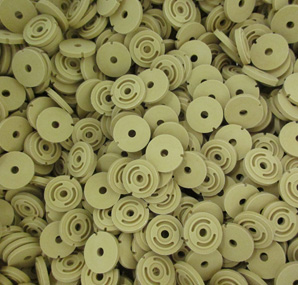PTFE Auto Molded Parts
PTFE is an excellent material for many different applications and operating environments. Its low friction, chemical compatibility, and ability to maintain key properties at extreme temperatures has made it ideal for everything from seals in sterile food handling equipment to sleeve bearings in the harsh world of oil and gas.
And there are several different options when it comes to manufacturing PTFE components, but not all methods are the same. In this blog post, we will be discussing auto molding in the context of manufacturing PTFE components.
What is Auto Molding?
Auto-molding, also known as compression molding, is a popular manufacturing technique for making thermoset and thermoplastic parts–and one of the oldest plastic forming methods still in use. In short, auto molding uses compression and dies to form a near net shape polymer part.
How PTFE Auto Molding Works
In the compression molding process, the raw materials are in the form of molding compounds. These molding compounds may be pre-forms (which is already shaped somewhat like the final part), granules, or putty-like masses.
The basic design for the mold is usually generated from a 3D CAD file, and the tool and die maker will then base the mold design on that file. However, the mold designer must account for shrinkage, molding compound flow, size and positioning of channels to carry away excess material, and achieving uniform curing temperatures for the part. It is also important to ensure that the part can be removed from the mold, and there may be a need for ejector pins to achieve this. Needless to say, the mold is the most expensive aspect of producing auto molded parts.
Once the mold design is complete, it is manufactured out of steel using a CAD/CAM (Computer-Aided Design / Computer Aided Manufacturing) system and a CNC (Computer Numeric Control) milling machine. Additional features and surface finishes may require post-processing of the mold.
Once the mold is ready to go, the amount of compound needed for the part is carefully measured out and placed in the pre-heated open mold cavity. Once in place, the other side of the mold closes over the mold cavity and pressure is applied (most often by a hydraulic ram) in one direction to force the raw materials to fill up all cavities within the mold. Any excess material is carried away from the mold via overflow grooves.
Heat and pressure are both maintained until the polymer has completely cured. Once the part has cured and cooled, it is removed from the mold, and this part of the process may require the use of part ejection pins to completely free the newly cured part from the mold. After the part is removed, any flash can be easily trimmed away and precision machining can be used to ensure the part meets necessary tolerances.
Want to learn more? Contact us today!
Tech Resources
Auto Molding PTFE
There are certain key aspects to auto molding PTFE compounds, including …
- Pressure (usually between 3,000 and 4,500 psi)
- Sintering temperature (in the range of 685°F – 720°F)
- Dwell time (how long the part is held at the sintering temperature)
Pressure and dwell time are dependent on the volume and geometry of the part, as well as the machine being used.
Benefits of Auto Molding
Auto molding PTFE has numerous benefits:
- Range of geometries and shapes are possible
- Can produce larger parts than possible with extrusion
- Minimal waste material
- Very cost-effective when compared to injection molding
- Good surface finish
- Close tolerances
- Avoids defects associated with machining a polymer (e.g., internal stresses, warping)
In addition, auto molding can be used with both virgin and filled PTFE. Fillers can include both those that enhance structural and material properties (e.g., carbon fiber, molybdenum disulfide MoS2) and colors. Depending on the size and geometry of the part, it may be possible to compression mold multiple parts simultaneously. In such cases, a multi-cavity die would be used.
Where is Auto Molding Used?
There are numerous industries that depend on auto molded parts, such as aerospace, chemical processing, and the manufacture of semiconductors.
Auto molding is used to manufacture a wide range of parts, as well. These include …
- Bearings
- Bushings
- Piston rings
- Sleeves
- Seals
- Gaskets
- Valves
- Valve Seats
- Diaphragms
- Bellows
- Electrical components
When compression molding of a PTFE part is done correctly, then you can depend on key aspects such as specific density, strength, elongation, and flex life as well as permeation resistance.


